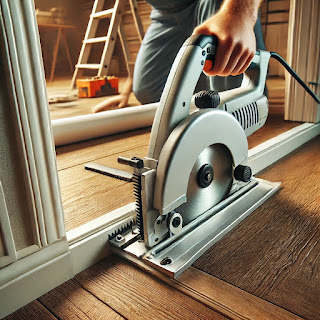A jamb saw, also known as an undercut saw, is an essential tool for anyone involved in flooring installations or door frame adjustments. It allows you to precisely cut door jambs and baseboards to fit flooring materials seamlessly. Whether you're a seasoned professional or a DIY enthusiast, knowing how to properly use a Dewalt jamb saw is crucial for achieving a clean and professional finish.
Understanding the Jamb Saw
A jamb saw is designed specifically to undercut door jambs and baseboards, making space for new flooring materials such as tile, laminate, or hardwood. This tool is particularly useful when you need to fit flooring under existing doorways without removing the door frame.
Key Features:
- Adjustable Blade Height: Allows for precise cuts at various heights.
- Ergonomic Handle: Provides better control and reduces fatigue during prolonged use.
- Durable Blade: Engineered to cut through wood, metal, and other materials effectively.
Step-by-Step Guide to Using a Jamb Saw
1. Preparation and Safety First
Before using a jamb saw, it's essential to prioritize safety:
- Wear Safety Gear: Always wear safety goggles, gloves, and ear protection.
- Check the Saw Blade: Ensure the blade is sharp and securely fastened.
- Clear the Area: Remove any debris or obstacles from the work area to avoid accidents.
2. Marking the Cut Line
- Measure the Flooring Thickness: Measure the thickness of the new flooring material.
- Mark the Jambs: Using a pencil, mark the door jambs and baseboards at the height of the flooring material plus a small clearance (typically 1/16 inch).
3. Adjusting the Jamb Saw
- Set the Blade Height: Adjust the saw's blade to the marked height. Ensure the blade is slightly higher than the flooring material to allow for easy installation.
- Test on a Scrap Piece: If available, test the saw on a scrap piece of wood to ensure the height is correct.
4. Making the Cut
- Position the Saw: Place the jamb saw flat against the floor with the blade aligned to the mark.
- Cut Slowly and Steadily: Turn on the saw and slowly guide it along the marked line, applying gentle pressure. Ensure you keep the saw level to avoid uneven cuts.
- Check the Fit: After making the cut, check the fit of the flooring material under the jamb. If necessary, make minor adjustments to ensure a snug fit.
5. Finishing Up
- Clean the Area: After cutting, clean up any sawdust or debris.
- Inspect the Cut: Ensure that the cut is clean and smooth, with no splinters or uneven edges.
- Install the Flooring: Proceed with installing the flooring, ensuring it fits perfectly under the cut jambs.
Tips for Using a Jamb Saw Effectively
- Use a Guide: Consider using a piece of flooring as a guide to maintain consistent cut height.
- Maintain Your Saw: Regularly clean the blade and lubricate the moving parts to keep the saw in optimal condition.
- Practice First: If you're new to using a jamb saw, practice on scrap material before tackling your project.
Common Mistakes to Avoid
- Cutting Too Deep: Always double-check the blade height to avoid cutting too deep into the jamb.
- Forgetting Safety Gear: Never skip wearing safety gear, as jamb saws can kick back and cause injuries.
- Rushing the Cut: Take your time to ensure a clean, straight cut. Rushing can lead to uneven edges and a poor fit.
FAQs About Using a Jamb Saw
1. What is the primary use of a jamb saw?
A jamb saw is primarily used to undercut door jambs and baseboards, allowing flooring materials to fit seamlessly underneath without removing the door frame.
2. Can a jamb saw cut through metal?
Yes, many jamb saws come with blades designed to cut through metal, making them versatile for various types of materials.
3. How do I choose the right blade for my jamb saw?
The choice of blade depends on the material you're cutting. For wood, a fine-tooth blade is ideal, while for metal, a blade with fewer, larger teeth is more effective.
4. Is it necessary to practice before using a jamb saw?
Yes, especially if you're new to using this tool. Practicing on scrap material helps you get a feel for the saw and ensures you make precise cuts when it matters.
5. What safety precautions should I take when using a jamb saw?
Always wear safety goggles, gloves, and ear protection. Ensure the work area is clear of debris, and check that the blade is securely fastened before use.
Conclusion
Using a jamb saw correctly can significantly enhance the quality of your flooring installation. By following the steps outlined above and adhering to safety guidelines, you can achieve professional results even if you're a DIY enthusiast. Remember, the key to a successful cut is preparation, precision, and patience.

Comments
Post a Comment